|
|
|
Sort Order |
|
|
|
Items / Page
|
|
|
|
|
|
|
| Srl | Item |
| 1 |
ID:
156539
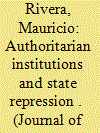

|
|
|
|
|
| Summary/Abstract |
Existing research has paid increasing attention to the role of political institutions such as legislatures and opposition parties in autocracies. So far, however, the relationship between nondemocratic institutions and state repression has remained largely unclear. This article argues that authoritarian institutions are related to divergent conflicting dynamics between incumbent regimes and opposition actors, which provide leaders with opposite incentives to repress. While authoritarian legislatures enhance leaders’ capacity to prevent conflict and reduce their need for repression, the presence of opposition parties helps opposition actors to overcome collective action barriers and mobilize against the incumbent regime, increasing the states’ need for repression. A panel data analysis of nondemocracies from 1976 to 2007 shows that authoritarian-elected legislatures reduce repression and the presence of opposition parties increases it. Moreover, the results indicate that autocracies with opposition parties and an elected legislature experience lower repression than autocracies with opposition parties but no elected legislature.
|
|
|
|
|
|
|
|
|
|
|
|
|
|
|
|
| 2 |
ID:
156533
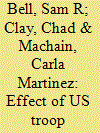

|
|
|
|
|
| Summary/Abstract |
US noninvasion troops deployed abroad often try to promote greater respect for human rights in the host country. The host country, having an incentive to retain the troop presence, may choose to comply with these requests. We argue that this effect will not be at play in states with high security salience for the United States (US) (for which the US may not be able to credibly threaten to remove the troops). In these cases, US deployments will provide the leader with security from both internal and external threats that is independent of the local population’s support for the leader. Host state leaders thus become less reliant on (and potentially less responsive to) their local populations, which in turn may lead to increased human rights violations. In this article, we use data on both US troop deployments abroad and on human rights violations to test these arguments from 1982 to 2005.
|
|
|
|
|
|
|
|
|
|
|
|
|
|
|
|
| 3 |
ID:
156536
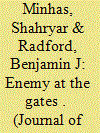

|
|
|
|
|
| Summary/Abstract |
There has been much disagreement about the relationship between civil wars and state economic performance. While civil war is often associated with poor economic performance, some states have managed robust growth despite periods of domestic armed conflict. We find this disagreement results from not accounting for the spatial distribution of conflict within a country. A robust literature in economics stresses the role major cities play in economic growth. We hypothesize that the economic impact of civil conflict is contingent on the conflict’s location relative to major urban centers within a state. We use subnational data on the location of conflict relative to urban areas to test the impact of domestic conflict on annual gross domestic product growth. In doing so, we bridge the economic development literature on the importance of cities with extant literature on the effect of armed conflict to provide a novel explanation for the paradox of high macroeconomic growth in conflict-ridden countries.
|
|
|
|
|
|
|
|
|
|
|
|
|
|
|
|
| 4 |
ID:
156537
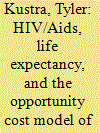

|
|
|
|
|
| Summary/Abstract |
This article views death in battle as an opportunity cost whose size is determined by the number of years a rebel would have lived as a civilian. As civilian life expectancy declines, this opportunity cost does too, increasing the probability of rebellion. This theory is tested with a tragic natural experiment: the HIV/AIDS epidemic in sub-Saharan Africa. Using male circumcision rates as an instrument for life expectancy, the analysis shows that a one-year increase in life expectancy decreases the probability of civil war by 2.6 percentage points. This supports the theory that opportunity costs are important determinants of conflict onset and that nonpecuniary opportunity costs should be taken into account. This article concludes by noting that cost–benefit analyses of public health interventions should include decreases in the probability of civil war, and the attendant benefits in terms of lives saved and material damage prevented, in their calculations.
|
|
|
|
|
|
|
|
|
|
|
|
|
|
|
|
| 5 |
ID:
156534
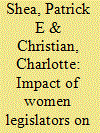

|
|
|
|
|
| Summary/Abstract |
In this article, we contend that the current gender and conflict literature ignores the context of military decisions and thus underestimates the support of women for certain types of military interventions. We argue that the issues related to humanitarian crises are likely to provoke support from women. Consequently, as more women enter elected positions in state legislatures, the more likely a state will become involved in a humanitarian military intervention. To test our argument, we compile a data set of humanitarian military interventions and women legislators from 1946 to 2003. A series of estimation approaches and robustness tests support our assertion that more women legislators impact the likelihood that a state will become involved in a humanitarian military intervention. Our research has specific implications on the role of gender in conflict processes and more general implications on the connection between domestic political processes and foreign policy decision making.
|
|
|
|
|
|
|
|
|
|
|
|
|
|
|
|
| 6 |
ID:
156535
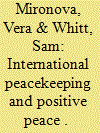

|
|
|
|
|
| Summary/Abstract |
To what extent can international peacekeeping promote micro-foundations for positive peace after violence? Drawing on macro-level peacekeeping theory, our approach uses novel experimental methods to illustrate how monitoring and enforcement by a neutral third party could conceivably enhance prosocial behavior between rival groups in a tense, postconflict peacekeeping environment. Using a laboratory experiment in postwar Kosovo, we find that third-party enforcement is more effective at promoting norms of trust between ethnic Serbs and Albanians than monitoring alone or no intervention at all. We then consider real-world extensions for building positive peace across different intervention environments. Using a dictator experiment that exploits heterogeneity in NATO peacekeeping in different regions of Kosovo, our inferences about monitoring and enforcement appear robust to ecological conditions in the field.
|
|
|
|
|
|
|
|
|
|
|
|
|
|
|
|
| 7 |
ID:
156541
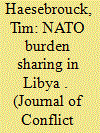

|
|
|
|
|
| Summary/Abstract |
This study aims to explain the pattern of contributions to NATO’s military campaign in Libya. It combines collective action theory with hypotheses on balance of threat, alliance politics, and domestic constraints in a multicausal framework, which is tested with qualitative comparative analysis. The results suggest novel inferences on the interactions between partisan politics, and the benefits states wish to secure by contributing to a multilateral operation. Contrary to conventional wisdom, parties situated at the left of the ideological spectrum were more inclined to support Operation Unified Protector than parties situated at the right. Whereas left-wing governments participated if they had the resources to contribute significantly to the fulfillment of the protection mandate and either highly valued their alliance with the United States or were not facing imminent elections, right-wing governments only contributed if their countries’ interests were threatened by the crisis in Libya or their participation was critical for the operation’s success
|
|
|
|
|
|
|
|
|
|
|
|
|
|
|
|
| 8 |
ID:
156538
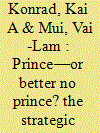

|
|
|
|
|
| Summary/Abstract |
Appointing a successor (the “prince”) allows the ruler (the “king”) to alter the structures of conflicts that take place between him and his potential challengers, as well as the structures of conflicts that take place among his potential challengers. Motivated by historical examples and using an infinite horizon rulership competition game, we show that while an appointed prince constitutes a powerful and dangerous threat to the incumbent ruler (the elevated threat effect), the appointed prince can also offer the incumbent ruler increased protection against other potential challengers (the barrier effect). We determine conditions when the overall effect of appointing a successor benefits the incumbent ruler and enables him to acquire a larger share of the governance rent in equilibrium.
|
|
|
|
|
|
|
|
|
|
|
|
|
|
|
|
| 9 |
ID:
156540
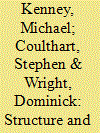

|
|
|
|
|
| Summary/Abstract |
This study combines network science and ethnography to explore how al-Muhajiroun, a banned Islamist network, continued its high-risk activism despite being targeted for disruption by British authorities. We analyze news reports, interviews, and field notes using social network analysis and qualitative content analysis to test hypotheses pertaining to network structure and performance. Our analysis suggests that the activist network’s structural properties had important implications for its performance during three separate time periods. What began as a centralized, scale-free-like, small-world network centered on a charismatic leader evolved into a more decentralized “small-world-like” network featuring clusters of local activists connected through multiple bridges. This structure allowed the activist network to engage in contentious politics even as its environment became increasingly hostile. We conclude by discussing the implications of al-Muhajiroun’s small-world solution for scholars and policy makers.
|
|
|
|
|
|
|
|
|
|
|
|
|
|
|
|
| 10 |
ID:
156542
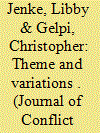

|
|
|
|
|
| Summary/Abstract |
Since its establishment in 1963, the Correlates of War (COW) project has sought to build cumulative knowledge about international conflict through the application of the scientific method to the study of militarized interstate behavior. Early analyses from the COW project found substantial variation in the causal model of war across the nineteenth and twentieth centuries, but COW scholars later sought to develop a general model of war that avoided post hoc historical periodization. We use out of sample cross validation to evaluate the plausibility of assuming temporal homogeneity for statistical models of international conflict that span the nineteenth and twentieth centuries. Our results suggest that the causal model of war changes substantially across historical eras. In particular, great care should be taken in generalizing Cold War findings to other historical eras. Our findings demonstrate the importance of exploring temporal variation in the causal model of war.
|
|
|
|
|
|
|
|
|
|
|
|
|
|
|
|
|
|
|
|
|